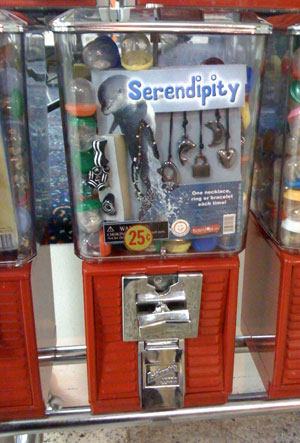Design for Serendipity
I’ve spent the last few years talking to magazine publishers, editors, and bookstore owners about the future of print in our digital age. And at some point in almost every conversation, the person I’m talking to uses the word “serendipity” when singing print’s praises.
 Serendipity is the moment of joy that comes from looking for one thing and finding another. In a magazine, this can happen when flipping pages. In a bookstore, it’s noticing an attractive book on your way down the aisle.
Serendipity is the moment of joy that comes from looking for one thing and finding another. In a magazine, this can happen when flipping pages. In a bookstore, it’s noticing an attractive book on your way down the aisle.
The implication in these conversations is that digital media somehow cannot create these happy accidental discoveries. But that’s just crazy talk.
Serendipity powers the social web. It’s why every website has a “share this” link. Serendipity is at the core of why Twitter is fun, YouTube is valuable, and everyone you know has a Facebook account.
YouTube is a great example. We’re all familiar by now with the phenomenon of getting caught in a string of YouTube videos. Watch just one cute cat video and at the end the site will suggest another. Then another. Then another. After a few minutes you’re somehow watching people race lawnmowers. That’s serendipity.
Google’s search results are another great example. How many times have you conducted a search only to find a link to something that wasn’t exactly what you were looking for, but was interesting anyway?
Serendipity is the last bastion of the print apologist. It’s the final straw grasped by people trying to justify their enduring love of print. Don’t get me wrong. I love print, too. I sell it! But I don’t want to prop up that love with bullshit.
There is a difference between serendipity in the physical world and digital serendipity: the digital kind has more potential. I can design a brick and mortar store window display and create a serendipitous experience for potentially hundreds of passers-by. Or I can do it online and reach millions.
Even though digital media is good at serendipity, a lot of it is accidental. The serendipity doesn’t occur on your website, it happens in Google or email or some other social site. But I suggest that’s because the designers of digital media are relying on the fabric of the web to create those experiences for them (and sometimes it does).
But we should be designing for serendipity. If you make a website, take a look at it and ask yourself, “when someone comes here looking for one thing, where do I have the opportunity to tell them about something else?” It could be in a footer, for example. This can be tricky, because you don’t want to interrupt a self-directed experience. Just look for the cracks where you can leave hints about what else is available. Hint: Newspapers have been designed this way for years. Crib, crib heartily.
Other notable examples of design for serendipity:
- On the New York Times website, when you scroll to the bottom of an article, another article slides out to tempt you.
- I already mentioned YouTube’s end-of-video links to related videos, but note also how much space in their current page design is devoted to “Suggestions” of other videos related to the one you’re on. Fully a third of the page! Serendipity keeps people on site, which is good for business.
- iPad app Flipboard is basically a serendipity engine, mapping your social graph from Twitter and Facebook, grabbing all the content they link to, and formatting it as a magazine for your serendipitous perusal. Print serendipity begets digital/social serendipity. Brilliant.
So to sum up, I have two things to say to two groups of people:
1. Designers of digital media: There are many serendipitous routes that lead people to your stuff. Understand what they are and nurture them. But don’t become over-reliant on them. Design your stuff to create serendipitous connections between things. Look for every opportunity to hint that there’s much more to be discovered. Take the time to design the serendipity in to the experience.
2. Lovers of print: I love print, too, and yes, there’s something very special about that moment when you’re flipping through a book or a magazine and you discover something new. But that experience can just as easily happen online, especially if designers are doing their jobs (see #1). But just because you have’t yet had a serendipitous experience in digital media, doesn’t mean it can’t happen. It just means designers have more work to do. But mostly you should just stop pretending that digital media cannot also be serendipitous. It just makes you look old, honey. Sorry.
+
Updates:
- Steven Johnson also pleaded Can We Please Kill This Meme Now in 2006. Apparently we can’t.
- David Murr suggested Wikipedia for serendipitous experiences, which is a great tip. Note that every page sports a random article link. A friend of mine once set his browser to use that as the default URL, so every time he opened a new browser window there was some random surprise there. I could never do that because I’m too easily distr….
- Ryan Brunsvold suggested a link he found via Jim Coudal: Globe Genie, which takes you to a random place in Google Earth. Fun!
- Can’t believe I forgot this until now: StumbleUpon‘s entire interaction model is based around happy surprise.
+
Do you have a great example of serendipity in digital media? Tweet it to me!
